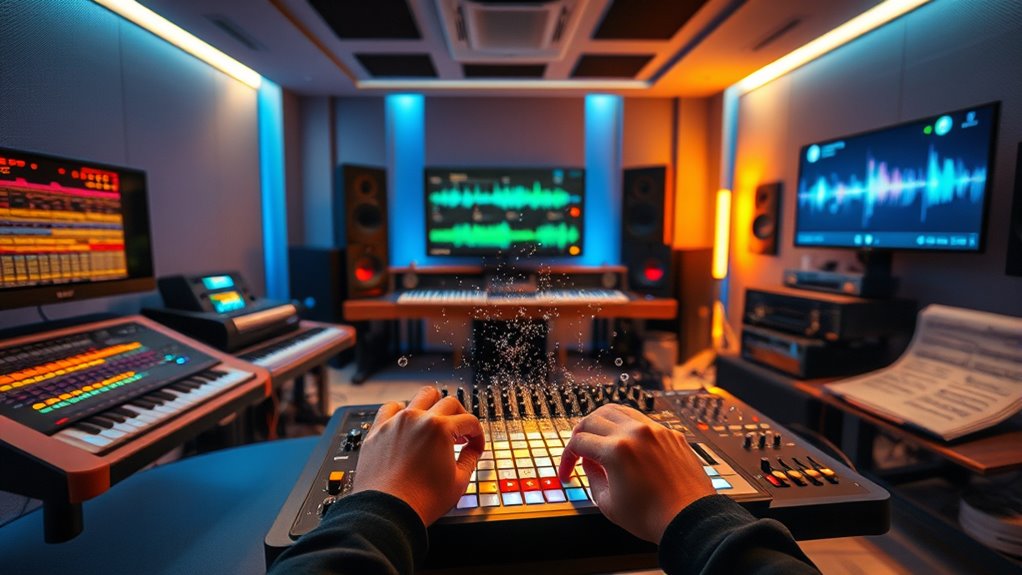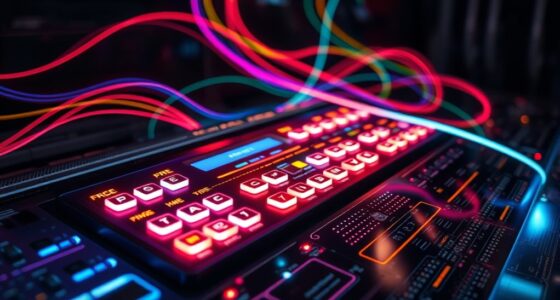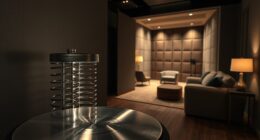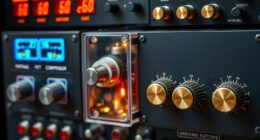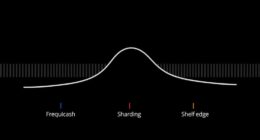Experiment with granular synthesis by creating lush textures, transforming field recordings into rhythmic or ambient layers, or manipulating vocals with glitches and chopped fragments. Use techniques like pitch-shifting, time-stretching, and spectral filtering to develop unique melodies and atmospheres. Combining granular methods with hardware or live control can spark spontaneous ideas and evolve sounds in real time. Keep exploring these approaches, and you’ll discover endless sonic possibilities for inspiring new song concepts.
Key Takeaways
- Experiment with transforming field recordings into rhythmic textures by granular stretching and pitch shifting to inspire new groove ideas.
- Use reverse grains and random positioning to create unpredictable ambient soundscapes that spark creative melodies.
- Layer manipulated vocal fragments with glitch effects to generate surreal textures for innovative song atmospheres.
- Automate grain density and pitch to evolve evolving textures that can serve as unique backing layers or intros.
- Combine granular synthesis with hardware control for live improvisation, leading to spontaneous melodic and rhythmic motifs.
Creating Ethereal Soundscapes With Granular Reverb Techniques
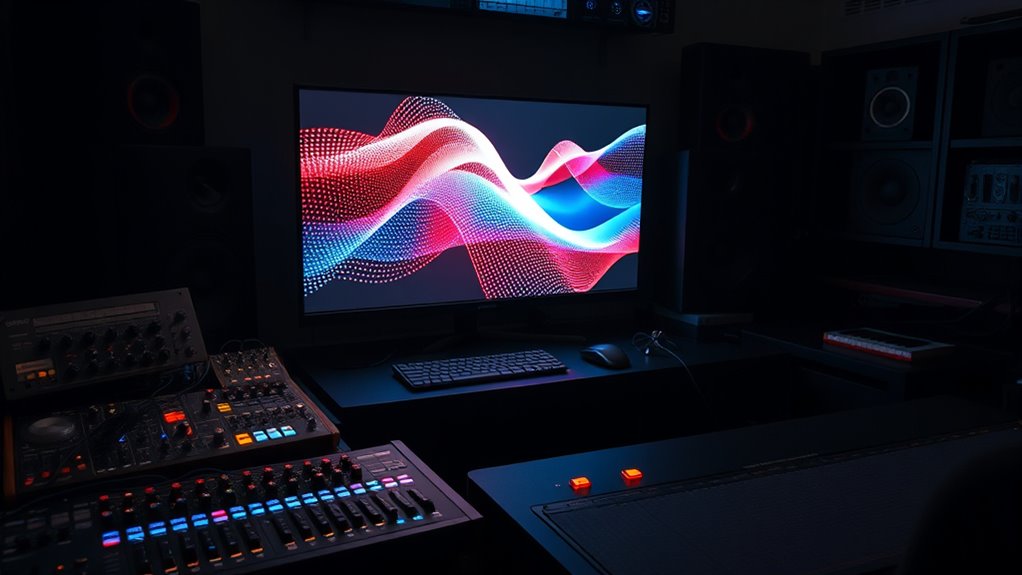
To create ethereal soundscapes with granular reverb techniques, you need to understand how to manipulate small audio particles to produce lush, immersive textures. Start by layering ambient textures that evoke a sense of space and depth. Use spectral filtering to shape these particles, emphasizing certain frequencies while suppressing others, which enhances the otherworldly feel. Adjust parameters like grain size and reverb decay to craft gradually evolving textures that feel seamless and expansive. Experiment with reversing grains or randomly varying their positions to add unpredictability. This approach allows you to craft lush atmospheres that breathe and shimmer, immersing the listener in a rich, textured environment. Engaging with innovative sound design techniques can further expand your creative possibilities. Mastering these techniques opens up new possibilities for creating enthralling, ethereal soundscapes.
Transforming Field Recordings Into Rhythmic Textures
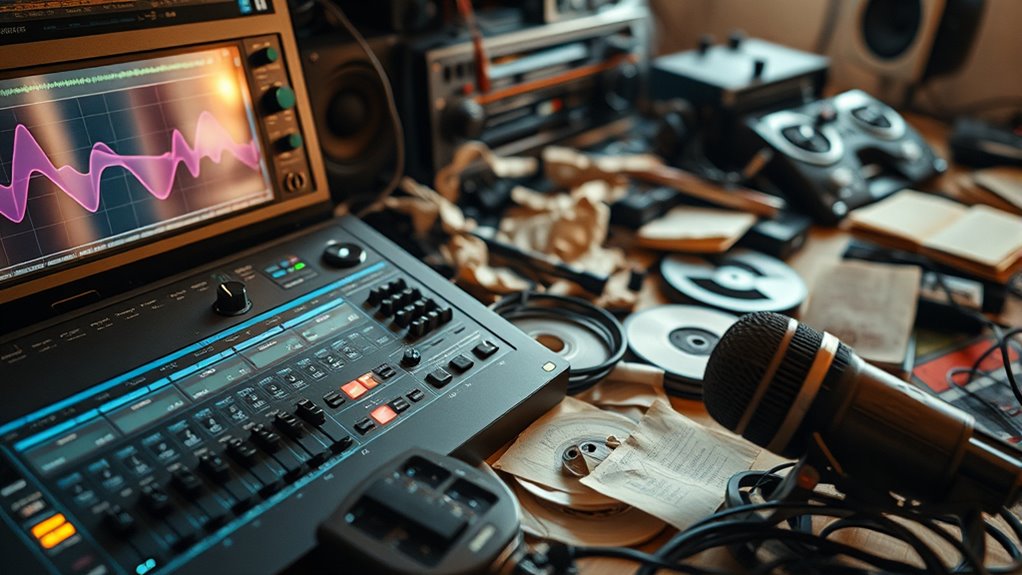
Transforming field recordings into rhythmic textures involves extracting percussive and tonal elements that can drive a pulse or groove within your soundscape. By isolating transient hits or emphasizing natural rhythms, you can create compelling rhythmic textures that complement ambient drone layers. Use granular synthesis to manipulate recordings, stretching or compressing sounds to emphasize rhythmic qualities. Consider these approaches:
- Isolate percussive elements from ambient textures for punchy rhythms
- Layer granular slices to build evolving, textured grooves
- Apply pitch shifting and timing variations to add complexity and movement
- Regularly assess and refine your approach to ensure the rhythmic textures align with your overall sound design goals
This process turns mundane recordings into dynamic, rhythmic foundations, enriching your soundscape with organic, unpredictable patterns. The key is balancing the ambient drone backdrop with rhythmic textures that add depth and interest.
Crafting Unique Vocal Manipulations and Glitched Effects
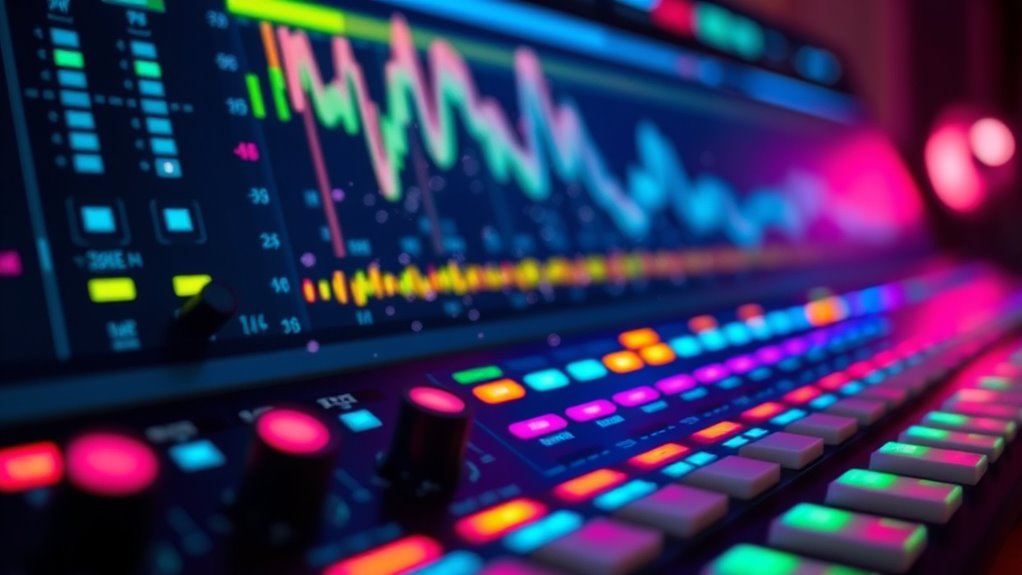
Vocal manipulations and glitched effects open a domain of creative possibilities, allowing you to reshape and distort voices into otherworldly textures. By experimenting with vocal chopping, you can slice recordings into rhythmic fragments, then rearrange or pitch-shift them for dynamic variations. Incorporate glitch effects by introducing digital artifacts, stutters, or skip-like disruptions that create a sense of digital decay. These techniques enable you to craft haunting melodies, rhythmic glitches, or surreal soundscapes that challenge traditional vocal use. Use granular synthesis to scatter vocal grains across time, producing stuttering or shimmering textures. Combining vocal chopping with glitch effects reveal a palette of sonic distortion, giving your tracks an experimental edge that sparks fresh ideas and pushes musical boundaries.
Designing Dynamic Atmospheres Using Grain Cloud Synthesis
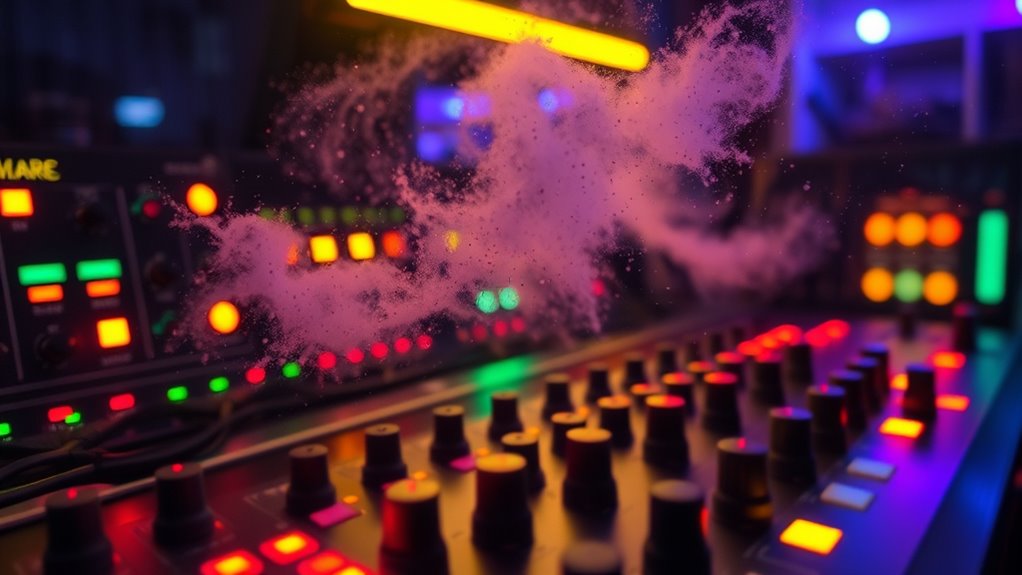
Grain cloud synthesis offers a powerful approach to crafting dynamic atmospheres that evolve and respond over time. By manipulating parameters like grain density, size, and pitch, you can create rich atmospheric modulation that shifts seamlessly. This method enables you to develop a compelling dynamic texture, giving your soundscape depth and movement. To achieve this, consider:
- Varying grain density to control the intensity of atmospheric layers
- Modulating grain pitch for subtle tonal fluctuations
- Automating grain envelope parameters to enhance evolving textures
- Incorporating energy-efficient techniques to optimize processing and reduce resource consumption
These techniques allow you to craft atmospheres that feel alive and responsive, making your soundscape more immersive. Grain cloud synthesis empowers you to shape complex, evolving environments that breathe and change, perfect for adding depth and atmosphere to your compositions.
Exploring Pitch-Shifting and Time-Stretching for Melodic Innovation
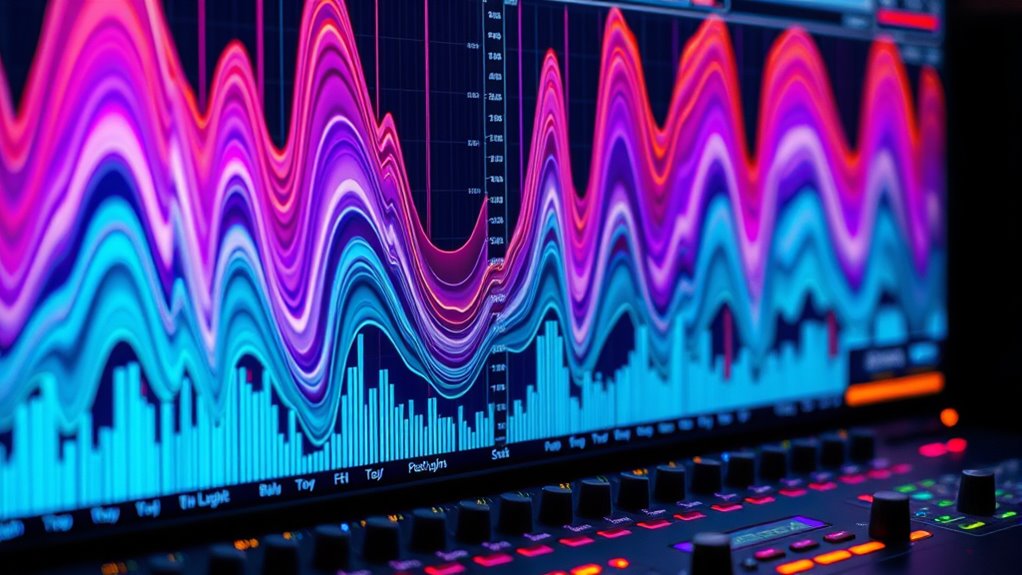
You can transform melodies by applying pitch-shifting techniques to create new tonal landscapes. Stretching time creatively allows you to explore unique rhythmic textures and evolving soundscapes. Combining melodic layers with these methods opens endless possibilities for innovative musical expression. Leveraging expert reviews can help identify the most effective tools and techniques for achieving desired sound transformations.
Pitch Manipulation Techniques
How can manipulating pitch and time transform your sound design? By leveraging granular modulation, you can create dynamic pitch shifts and subtle pitch bending effects that add expressiveness. Pitch manipulation allows you to craft melodies from static sounds, making them more lively. Techniques include fine-tuning granular parameters to achieve smooth pitch transitions or dramatic shifts. You can also experiment with pitch bending within granular synthesis to produce fluid, organic movements. Additionally, understanding color accuracy enhances your ability to perceive subtle tonal shifts caused by pitch modulation, leading to more precise sound design choices.
- Use granular modulation to subtly alter pitch for evolving textures
- Apply pitch bending for expressive, melodic contours
- Combine pitch-shifting with time-stretching for unique soundscapes
These methods facilitate new melodic possibilities, transforming familiar sounds into innovative sonic motifs.
Stretching Time Creatively
By creatively stretching time through granular synthesis, you can transform familiar sounds into entirely new melodic textures. This technique allows you to manipulate rhythmic complexity, creating intricate patterns that challenge traditional timing. As you elongate sounds, you reveal subtle details and introduce unexpected rhythmic layers, adding depth to your music. Additionally, time-stretching opens avenues for harmonic exploration by shifting pitches without altering tempo, enabling you to experiment with unusual tonal combinations. You can stretch a vocal sample or instrumental snippet to craft evolving textures that feel both organic and surreal. This approach encourages you to rethink melodic flow, blending rhythmic intricacy with harmonic innovation. Incorporating sound manipulation techniques can further enhance your creative possibilities, ultimately expanding your sonic palette, inspiring fresh ideas, and surprising musical directions.
Melodic Layering Ideas
Building on the creative manipulation of time, combining pitch-shifting with time-stretching reveals a wealth of melodic possibilities. You can craft unique harmonic blending by adjusting pitches of granular layers, creating new tonal textures. Rhythmic layering becomes dynamic as you shift pitches at different rates, adding complexity to your melodies. This approach allows you to experiment with subtle pitch variations that enhance harmonic richness or dramatic shifts for contrast. By blending multiple granular layers with varied pitch and timing, you generate evolving melodic contours. Incorporating sound synthesis techniques can further expand your sonic palette, enabling even more innovative melodic experiments.
Combining Granular Synthesis With Modular Hardware for Live Performance
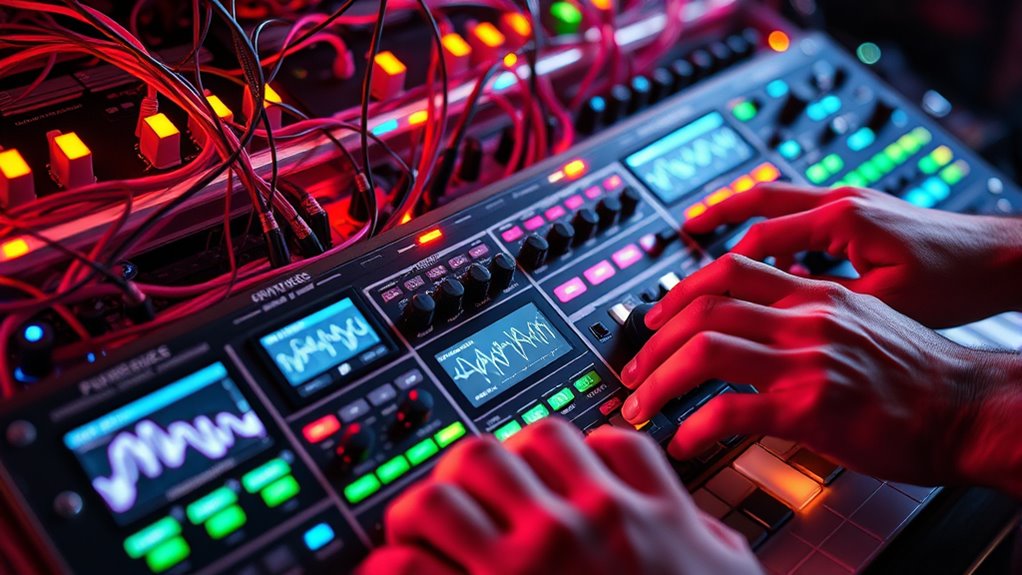
You can enhance your live performances by integrating granular synthesis with modular hardware, enabling flexible sound manipulation on the fly. Mastering hardware integration techniques guarantees your setup is stable and responsive, while real-time sound control keeps your performance dynamic. Optimizing your workflow allows you to focus on creativity without getting bogged down by technical issues. Incorporating sound design techniques can further elevate your sonic experimentation during live shows.
Hardware Integration Techniques
Integrating granular synthesis with modular hardware opens exciting possibilities for live performance, allowing you to manipulate complex textures in real time with tactile control. You can connect your synth hardware to granular modules via CV or audio signals, creating dynamic soundscapes. Using MIDI controllers, you can assign knobs and pads to control parameters like grain size, density, or pitch, giving you immediate expressive power. To optimize your setup, consider:
- Using MIDI controllers for intuitive parameter adjustments
- Incorporating CV outputs from modular gear to modulate granular parameters
- Routing synth hardware directly into granular modules for seamless sound processing
This approach enables precise control over granular textures while maintaining hands-on interaction, elevating your live performance capabilities.
Real-Time Sound Manipulation
Combining granular synthesis with modular hardware in a live setting opens powerful avenues for real-time sound manipulation. You can use granular modulation to dynamically alter parameters like grain size, density, and pitch, creating evolving sound textures on the fly. By patching modules to control these parameters, you gain intuitive hands-on control over complex sonic changes. This approach allows you to morph textures seamlessly, blending granular processing with traditional synthesis methods. The immediacy of hardware ensures minimal latency, so your sound evolves naturally during performance. You’re not just triggering sounds—you’re sculpting rich, layered soundscapes in real time. This setup empowers you to experiment freely, responding to the environment or audience, and sparking spontaneous musical ideas through tactile, granular control of your sound texture. Additionally, integrating digital sound synthesis techniques can further expand your sonic palette, allowing for more unique and customizable sound design possibilities.
Performance Workflow Optimization
To optimize your performance workflow when working with granular synthesis and modular hardware, establishing a clear, organized setup is essential. Keeping your gear accessible and well-labeled helps streamline your process. Use MIDI mapping to assign controls for real-time adjustments, enabling quick responses during performance. Incorporate live looping to layer textures seamlessly, enhancing improvisation. Consider these ideas:
- Create dedicated MIDI controllers for granular parameters and modular modules
- Design a systematic signal flow to reduce clutter and confusion
- Practice integrating live looping with modular hardware to improve timing and progressions
This setup allows you to switch between granular textures and live looping effortlessly, ensuring a fluid, dynamic performance. Efficient workflow minimizes technical distractions, letting your creativity shine through.
Frequently Asked Questions
What Are the Best Software Options for Granular Synthesis Experiments?
When exploring granular synthesis experiments, you want the best software options for your creative process. Look for granular plugins like Ableton’s Granulator II or Output’s Portal, which offer versatile features. Pair them with all-encompassing synthesis tutorials to master techniques quickly. These tools help you craft unique sounds, inspiring new song ideas. With the right setup, you’ll find endless sonic possibilities, turning experimentation into fresh musical inspiration.
How Can I Synchronize Granular Effects With Other Digital or Analog Instruments?
Imagine your granular effects as a river flowing alongside your instruments. To keep them in harmony, you can use tempo locking, ensuring your effects match your track’s BPM, and modulation synchronization, so parameters shift in time with your instruments. Connecting your gear via MIDI or CV allows precise control, making your granular textures seamlessly blend with both digital and analog setups, creating a cohesive, dynamic soundscape.
What Are Common Pitfalls When Experimenting With Granular Synthesis Techniques?
When experimenting with granular synthesis techniques, you should watch out for common pitfalls like parameter overload, which can make your sounds cluttered and chaotic. Timing inaccuracies are also a challenge, especially when syncing granular effects with other instruments. To avoid these issues, start with simple settings, keep your parameters organized, and always double-check your timing to confirm your sounds stay cohesive and musical.
How Does Granular Synthesis Influence the Emotional Tone of a Track?
Imagine sound as a painter’s palette — granular synthesis adds strokes of unpredictability, shaping your emotional impact. It influences the emotional tone of your track by transforming sound texture into a vivid canvas of mood and atmosphere. You can evoke serenity, chaos, or nostalgia, depending on how you manipulate grain size and density. This technique empowers you to craft emotionally charged music, turning simple sounds into powerful stories that resonate deeply with your audience.
Can Granular Synthesis Be Effectively Integrated Into Live DJ Performances?
You can definitely integrate granular synthesis into live DJ performances, enhancing live remixing and crowd interaction. By manipulating sounds in real-time, you create unique textures that captivate your audience. Use granular synthesis to build tension or add atmospheric layers, making your set dynamic and engaging. It’s a powerful tool that transforms traditional DJ sets, allowing you to experiment and respond to the crowd’s energy instantly, creating a memorable live experience.
Conclusion
By experimenting with these granular synthesis techniques, you can unseal fresh, inspiring song ideas. Don’t be afraid to push boundaries and explore new textures—after all, variety is the spice of creativity. Keep experimenting with sound, and you’ll find that every grain holds potential for something unique. Remember, the journey of discovery often begins where your comfort zone ends, so embrace the chaos and let your creativity soar.

